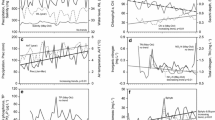Abstract
Discussion and conclusions are presented from a workshop held at Balatonfüred, Hungary in May 2002 on the role of water-level fluctuations on the structure and function of shallow lakes. Water-level regime is regarded to be an important factor for lake ecosystem functioning and affects conservation values. Biota, in particular those living in vegetated areas, respond differentially to changes in hydroperiod dynamics. Extreme water levels may cause shifts between the turbid and the clear, macrophyte-dominated state. Strong effects of anthropogenic changes in the fluctuation of water levels are shown for Mediterranean (Greece, Turkey) and north temperate (The Netherlands) regions. Additionally, effects of climate change are anticipated that might alter the functioning of shallow lakes in these regions differentially. There is a need for data on the relationships between water-level changes and ecosystem responses. A plea is made for international cooperation and information exchange and an internet site for facilitating this has been developed.
Similar content being viewed by others
References
Beklioglu, M., G. Altinayar & C. O. Tan, 2001. Role of water level fluctuations, nutrients and fish in determining the macrophytedominated clear water states in five Turkish shallow lakes. Shallow Lake Wetlands: Ecology, Eutrophication and Restoration. International Workshop, 28–30 October 2001, Ankara, Turkey.
Blindow, I., 1992. Long-and short-term dynamics of submerged macrophytes in two shallow eutrophic lakes. Freshwat. Biol. 28: 15–27.
Chapman, L. J., 2001. Fishes of African rain forests: diverse adaptations to environmental challenges. In Weber, W., L. J. T., White, A Vedder & L. Naughton-Treves (eds), African Rain Forest Ecology and Conservation. Yale University Press, New Haven: 263–290.
Coops, H. & S. H. Hosper, 2002. Water-level management as a tool for the restoration of shallow lakes in the Netherlands. Lake and Reservoir Management 18: 292–297.
Gafny, S. & A. Gasith, 1999. Spatially and temporally sporadic appearance of macrophytes in the littoral zone of Lake Kinneret, Israel: taking advantage of a window of opportunity. Aquat. Bot. 62: 249–267.
Hollis, G. E. & A. C. Stevenson, 1997. The physical basis of the Lake Mikri Prespa systems: geology, climate and water quality. Hydrobiologia 351: 1–19.
Karakhanian, A., P. Tozalakyan, J. C. Grillot, H. Philip, D. Melkonyan, P. Paronyan & S. Arakelyan, 2001. Tectonic impact on the Lake Sevan environment (Armenia). Environ. Geol. 40: 279–288.
Leslie, A. J., T. L. Crisman, J. P. Prenger & K. C. Ewel, 1997. Benthic macroinvertebrates of small Florida pondcypress swamps and the influence of dry periods. Wetlands 17: 447–455.
Loaiciga, H. A., J. B. Valdes, R. Vogel, J. Garvey & H. Schwarz, 1996. Global warming and hydrological cycles. J. Hydrol. 174: 83–127.
Nöges, T. & P. Nöges, 1999. The effect of extreme water-level decrease on hydrochemistry and phytoplankton in a shallow eutrophic lake. Hydrobiologia 408/409: 277–283.
Pyrovetsi, M. & G. Daoutopoulos, 1989. Conservation-related attitudes of lake fishermen in Greece. Environ. Conserv. 16: 245–250.
Pyrovetsi, M. & G. Daoutopoulos, 1997. Contrasts in conservation attitudes and agricultural practices between farmers operating in wetlands and a plain inMacedonia,Greece. Environ. Conserv. 24: 76–82.
Tan, C.O., 2002. The roles of hydrology and nutrients in alternative equilibrium of two shallow lakes of Anatolia, Lake Eymir and Lake Mogan: using monitoring and modeling approaches. MSc Thesis, Middle East Technical University, Ankara, Turkey.
Ter Heerdt, G. N. J. & H. J. Drost, 1994. Potential for the development of marsh vegetation from the seed bank after a drawdown. Biol. Conserv. 67: 1–11.
Wallsten, M. & P. O. Forsgren, 1989. The effects of increased waterlevel on aquatic macrophytes. J. Aquat. Plant Manag. 27: 32–37.
Author information
Authors and Affiliations
Rights and permissions
About this article
Cite this article
Coops, H., Beklioglu, M. & Crisman, T.L. The role of water-level fluctuations in shallow lake ecosystems – workshop conclusions. Hydrobiologia 506, 23–27 (2003). https://doi.org/10.1023/B:HYDR.0000008595.14393.77
Issue Date:
DOI: https://doi.org/10.1023/B:HYDR.0000008595.14393.77




